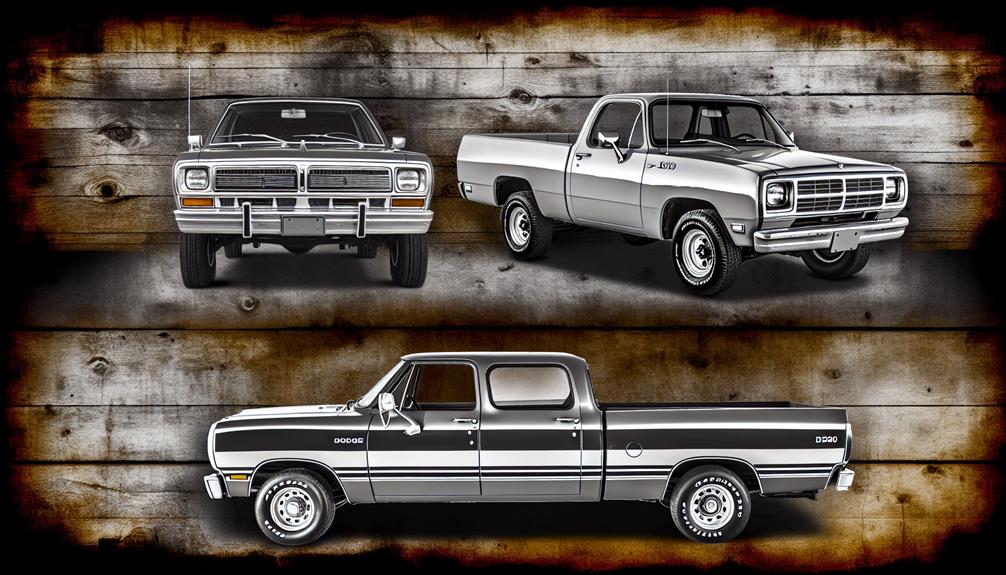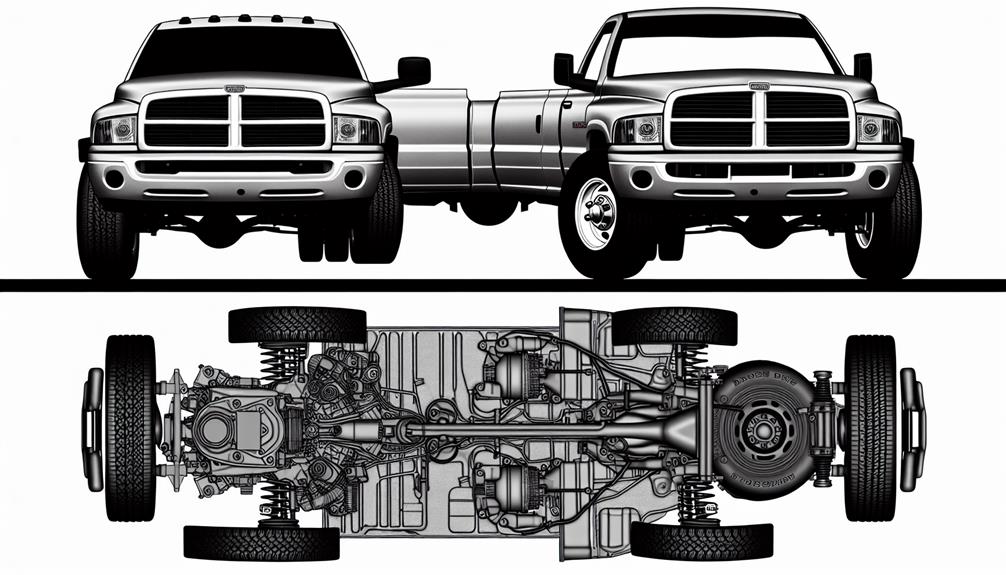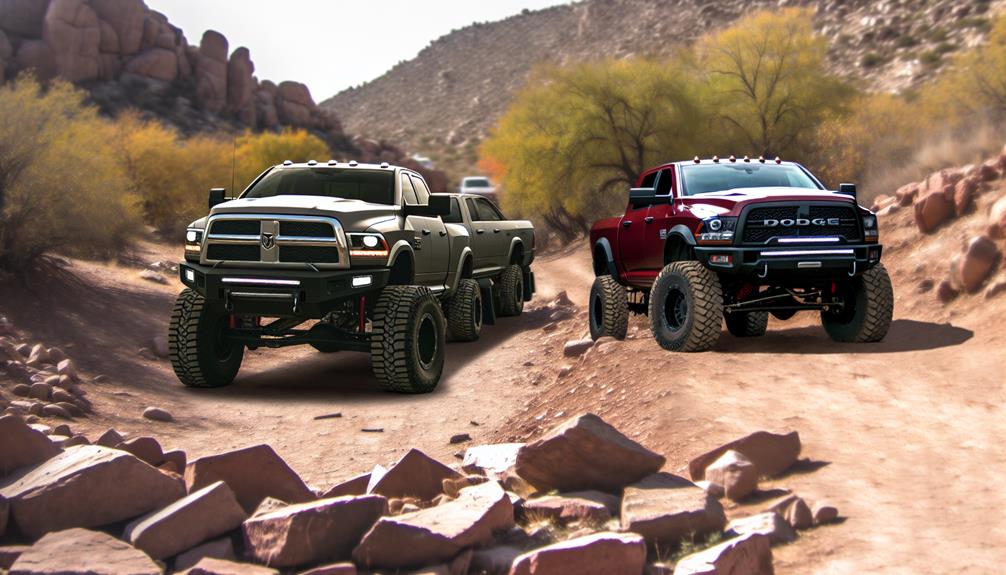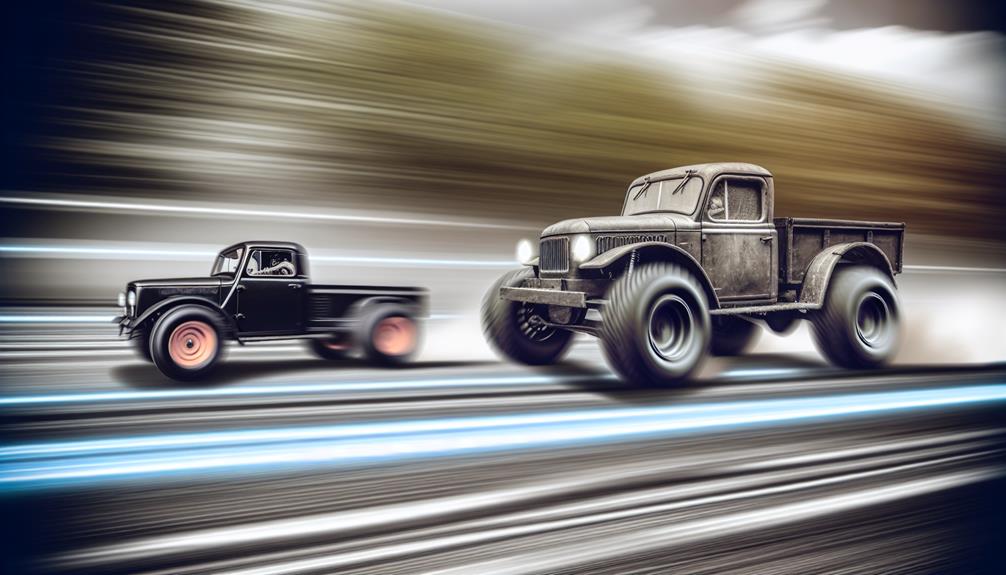Nearly 80% of vintage truck enthusiasts have debated the merits of the Dodge W250 versus the D250 at some point, highlighting the passionate following these models have.
You might find yourself weighing the rugged, off-road readiness of the W250 against the more road-tuned sensibilities of the D250. As you consider your options, keep in mind that the W250’s 4-wheel drive system sets it apart for those who favor durability and all-terrain capability, while the D250’s 2-wheel drive configuration could offer a smoother ride and potentially better fuel efficiency for daily use.
Pondering over which classic Dodge truck suits your lifestyle and meets your needs might lead you down a path of detailed comparisons and tough decisions. What’s important is understanding the subtleties that define each model’s performance, comfort, and reliability over time.
So, let’s explore the nuances that could sway your preference between these two titans of the truck world.
Contents
Key Takeaways
- The Dodge W250 and D250 trucks had distinct drivetrain configurations, with the W250 being a 4WD truck and the D250 offering a 2WD setup.
- The W250 had a higher price tag due to its advanced 4WD capabilities, while the D250 appealed to drivers looking for practicality and fuel efficiency.
- The W250 generally surpasses the D250 in towing and payload capacities, making it ideal for heavier trailers or boats.
- The W250’s 4WD system is suitable for rugged terrain and challenging conditions, while the D250’s 2WD layout offers fuel efficiency and is more suitable for paved roads or light-duty paths.
Historical Context

Exploring the historical context of Dodge’s W250 and D250 trucks, you’ll find that their distinct drivetrain configurations not only shaped their utility and performance but also mirrored broader trends in automotive design and consumer preference during their time of production.
The Dodge W250, a robust 4WD truck, could tackle tougher terrains with ease, making it a go-to for off-road enthusiasts and those requiring dependable work vehicles. Its counterpart, the D250, offered a 2WD setup that appealed to drivers looking for practicality and fuel efficiency on paved roads.
You’d notice the W250’s higher price tag was a direct reflection of its advanced 4WD capabilities, which inevitably influenced its demand and resale value. Before the mid-1990s, Dodge utilized the D and W coding to distinguish between two and four-wheel drives. However, the introduction of the BR designation with a body style change in ’94 marked the end of this era.
The ’89 W250, with its standard cab and long bed, represents these models’ durability, albeit issues like rusty brake and transmission cooling lines, along with a leaking rear main crank seal, are reminders of the maintenance demands these trucks can present. Converting a D250 to 4WD isn’t just a hefty task; it’s a nod to the enduring appeal of the Dodge 4×4 legacy.
Engine Specifications

You’ll find that the heart of any truck comparison lies in the engine specifications, where the Dodge W250 and D250 showcase their unique strengths.
Assessing powertrain performance metrics will reveal not just horsepower and torque differences, but also how these trucks manage fuel efficiency.
Furthermore, understanding their towing and payload capacities is essential to gauge which model aligns with your power and utility needs.
Powertrain Performance Metrics
When comparing the Dodge W250 and D250, it’s crucial to examine their engine specifications, as factors like displacement, horsepower, torque, compression ratio, fuel efficiency, and emissions compliance significantly influence performance.
Displacement gives you a glimpse of their potential power, where a higher value suggests a larger engine capable of more output.
Horsepower and torque directly indicate how each truck will perform under load, with torque playing a key role in towing and hauling capabilities.
The compression ratio affects both power and fuel economy, making it a balancing act between performance and efficiency.
You’ll also want to consider how well each truck’s engine converts fuel into motion, and whether they meet the latest emissions standards, ensuring you’re driving a vehicle that’s powerful and responsible.
Fuel Efficiency Comparison
Fuel efficiency varies notably between the Dodge D250 and W250, as the former’s lighter 2-wheel drive system and the latter’s heavier 4-wheel drive setup influence their respective fuel consumption. When you’re considering the fuel efficiency comparison, remember that your driving environment and habits will play a significant role.
The D250 might be your go-to for lighter workloads and smoother roads, where its efficiency shines. However, the W250’s capability on tougher terrains could justify its extra thirst for fuel.
| Aspect | Dodge D250 | Dodge W250 |
|---|---|---|
| Drivetrain | 2-wheel drive | 4-wheel drive |
| Weight | Lighter | Heavier |
| Engine Options | Gas and Diesel | Gas and Diesel |
| Terrain Handling | Urban/Highway | Off-Road/Varied |
| Fuel Efficiency | Generally Better | Lower Due to 4WD |
Your choice hinges on the balance between the need for efficiency and the demand for rugged performance.
Towing and Payload Capacities
While considering the fuel efficiency of the Dodge D250 and W250 is important for your daily drives, it’s crucial to examine their towing and payload capacities if you’re aiming to haul heavy loads.
The Dodge W250, with its robust 4WD system, generally surpasses the D250 in these areas:
- Dodge W250:
- *Higher towing capacity*: Ideal for pulling heavier trailers or boats.
- *Greater payload*: Confidently load up heavier equipment or materials.
In contrast, the D250’s 2WD configuration offers its own advantages, though it may not match the W250’s muscle:
- D250:
- *Adequate for lighter loads*: Better suited for everyday cargo rather than extreme weight.
- *Smoother on-road performance*: Optimized for paved surfaces rather than rugged terrain.
Analyzing the towing and payload capacities helps you align with the truck that meets your specific needs.
Drivetrain Differences

As you consider the Dodge W250 and D250 models, it’s crucial to understand how their drivetrains set them apart.
The W250’s four-wheel drive system equips you with rugged terrain and challenging conditions. This feature is perfect for off-road enthusiasts or individuals who frequently encounter rough driving conditions. With the four-wheel drive, you can confidently navigate through mud, snow, and uneven terrain.
On the other hand, the D250’s two-wheel-drive layout might save you at the pump and offer a more relaxed cruise on highways. This configuration is ideal for individuals who primarily drive on paved roads and do not require the added traction and capability of four-wheel drive. Additionally, the two-wheel drive system typically results in better fuel efficiency, which can be advantageous for long highway journeys.
Analyzing the powertrain configurations reveals each truck’s suitability for distinct driving needs and lifestyles. Whether you prioritize off-road capability or fuel efficiency, understanding these differences will help you make an informed decision about which model best fits your requirements.
Four-Wheel Vs. Two-Wheel
When deciding between the Dodge W250 and the D250, it’s crucial to understand that the core distinction lies in their drivetrains: the former offers the robustness of four-wheel drive, while the latter provides the simplicity and efficiency of the two-wheel drive. Your choice should reflect your driving demands:
4WD (W250)
- *Navigate rocky trails* akin to a Jeep Grand adventure
- *Plow through snowdrifts* with confidence, as 4WD doesn’t shy away from challenging weather
2WD (D250)
- *Cruise on highways* with a lighter vehicle that’s gentle on your wallet at the pump
- *Maneuver urban streets* with ease, enjoying lower maintenance costs
Powertrain Configuration Comparison
Understanding the difference in drivetrain configurations between the Dodge W250 and D250 is essential to gauge how each truck will perform under various conditions, with the former’s 4WD system offering superior traction and the latter’s 2WD setup providing potential fuel economy benefits.
The W250’s 4WD is a game-changer when you’re facing challenging terrains or inclement weather. Its powertrain has been expanded to include features that enhance stability and off-road prowess.
Meanwhile, the D250 might save you some cash at the pump thanks to its 2WD configuration. Bear in mind that converting a D250 to match the W250’s 4WD capability is a costly endeavor, and such modifications can affect both performance and ongoing maintenance requirements.
Your choice may ultimately hinge on whether you prioritize rugged capability or fuel efficiency.
Exterior Design Features

Distinguishing the W250 and D250 models, the former’s robust exterior design caters to off-road enthusiasts with its higher ground clearance and rugged features, while the latter’s sleeker profile appeals to those preferring smooth urban driving. When you’re assessing these two Dodge models, it’s essential to consider how their design influences not just aesthetics but also functionality.
W250 Exterior Design:
- Higher ground clearance for a formidable off-road presence
- May include a front axle disconnect to enhance off-road capabilities
- Rugged appearance indicative of its 4WD utility
D250 Exterior Design:
- Sleeker, more streamlined profile for urban environments
- Lighter construction due to the absence of the 4WD system
- Optimized for better fuel efficiency and smoothness on paved roads
The W250’s design is tailored for traction and stability across challenging terrains, reflecting the demands of drivers who tackle diverse landscapes. In contrast, the D250 offers a smoother experience on the tarmac, where its lighter weight can translate into more nimble handling and potentially better performance.
Depending on where you live and what you demand from a truck, the choice between the Dodge W250 and D250 could hinge on these critical design distinctions.
Interior Comforts
While the exterior designs of the W250 and D250 cater to different driving environments, the interiors focus on ensuring driver and passenger comfort regardless of the terrain.
Delving into these models, you’ll find that both may flaunt spacious cabins that invite you to settle in for the long haul. Comfort isn’t an afterthought; it’s a priority, with seating designed to support you mile after mile.
Dive deeper, and you’ll notice the amenities that could grace these trucks. Some D250 and W250 variants might pamper you with air conditioning, power windows, and adjustable seating—features that transform a rugged ride into a sanctuary from the outside elements. The potential for an upgraded audio system is there too, turning each journey into an opportunity for an immersive listening experience.
Materials matter when it comes to interior comfort, and you’ll see a range of options that could include fabric or leather seating surfaces. Each choice speaks to a different aesthetic and tactile preference, providing a tailored touch to your truck’s cabin.
Analyzing these trucks reveals a thoughtful approach to interior design, one that complements their stout exteriors with a focus on comfort, convenience, and enjoyment.
Off-Road Capabilities

When tackling treacherous terrain, the W250’s 4WD system gives it a definitive edge, offering superior traction and stability that off-road enthusiasts demand. Imagine the scenarios where this capability shines:
- Climbing steep, muddy hills where the W250’s 4WD claws into the earth
- Torque evenly distributed to all four wheels
- Reduced wheel slip compared to the D250’s 2WD
- Traversing rocky trails that would challenge the D250’s balance
- The sturdy front axle of the W250 navigates obstacles
- Transfer case providing the necessary power to push through
You’ll find the D250, being 2WD, is more at home on paved roads or light-duty paths. Its lighter weight and potential for better fuel efficiency might tempt you, but when the road ends and the wild begins, it’s the W250 that’s equipped to take you further.
Upgrading a D250 to 4WD isn’t a simple bolt-on affair; it requires significant modifications. These changes could enhance its off-road prowess, yet it’s an investment of time and resources that the W250 simply doesn’t need. Plus, with the W250’s likely higher towing capacity, you’re not just conquering landscapes; you’re bringing everything you need along for the adventure.
On-Road Performance

Navigating through city streets and highways, you’ll appreciate the D250’s smoother ride and potential for better fuel efficiency, a stark contrast to the rugged W250’s on-road demeanor. The D250’s 2WD setup not only shaves off some weight but also reduces the complexity, which translates into a more comfortable driving experience for daily commutes and long journeys alike.
While you might think the W250’s 4WD system is overkill for the tarmac, it does have its moments, especially in adverse weather conditions or on roads with poor traction. However, for regular driving scenarios, the D250’s on-road finesse is likely to win you over.
Take a look at this comparative table to get a quick rundown:
| Aspect | Dodge D250 | Dodge W250 |
|---|---|---|
| Drive System | 2WD (Rear-Wheel Drive) | 4WD (Four-Wheel Drive) |
| Ride Smoothness | Generally smoother on roads | Stiffer due to 4WD hardware |
| Fuel Efficiency | Potentially better | Lower due to 4WD system |
| Towing Capacity | Adequate for on-road use | Higher, but less relevant |
Analyzing the specs, it’s clear that if your main stage is the urban jungle, the D250 is the more prudent choice. You’ll not only save at the pump but also relish a ride that’s tailored for the pavement, without sacrificing much in terms of utility.
Ownership Considerations
As you consider the long-term implications of owning a Dodge D250 or W250, it’s crucial to factor in how the drivetrain choice will affect your off-road adventures and fuel expenses.
The D250’s 2WD layout may be kinder to your wallet at the pump, but it won’t take you as far into the wild as the W250 with its robust 4WD.
When you’re weighing the pros and cons, consider these points:
- Drivetrain and Performance:
- The W250’s 4WD is ideal for rough terrain, but expect higher fuel costs.
- Modifying a D250 for 4WD can give you off-road prowess, but with a steep investment in time and money.
- Maintenance and Upgrades:
- Rebuilding the suspension on either model can dramatically improve ride quality.
- Be sure you’re ready for the potential expense and check the frame’s condition first.
- Automatic W250/350 models offer convenience but can incur greater repair costs.
Market factors also play a role:
- The W250 might fetch a higher resale value, especially in regions where four-wheel drive is in high demand.
- Availability of parts can vary by location, influencing maintenance costs for both models.
Choose wisely, as your decision will shape your driving experience and ownership costs for years.
Conclusion
You’ve seen the distinctions between the robust Dodge W250 and the efficient D250.
While the W250’s 4WD prowess offers superior off-road potential, the D250 shines on pavement with its lighter frame and potential fuel savings.
Your choice hinges on utility versus economy, rugged adventure versus urban agility.
Both models promise distinctive advantages, but it’s the balance of your practical needs and personal desires that will steer you toward the truck that best suits your lifestyle.
Choose wisely and hit the road with confidence.
